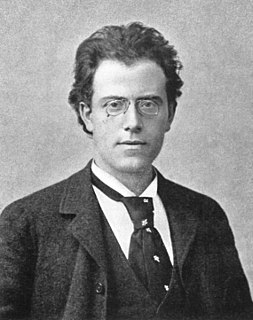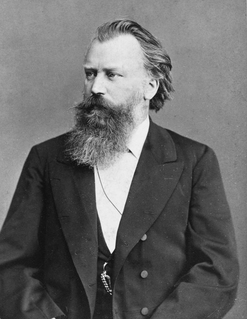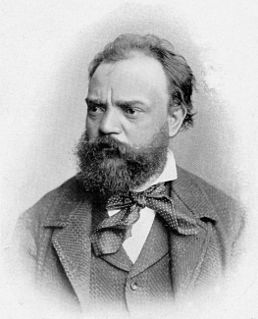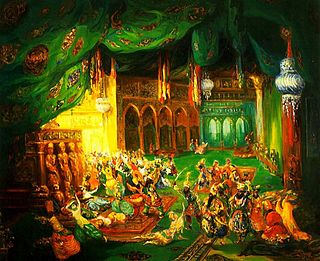Related Research Articles

The Symphony No. 1 in D major by Gustav Mahler was mainly composed between late 1887 and March 1888, though it incorporates music Mahler had composed for previous works. It was composed while Mahler was second conductor at the Leipzig Opera, Germany. Although in his letters Mahler almost always referred to the work as a symphony, the first two performances described it as a symphonic poem and as a tone poem in symphonic form respectively. The work was premièred at the Vigadó Concert Hall, Budapest, in 1889, but was not well received. Mahler made some major revisions for the second performance, given at Hamburg in October 1893; further alterations were made in the years prior to the first publication, in late 1898. Some modern performances and recordings give the work the title Titan, despite the fact that Mahler only used this label for the second and third performances, and never after the work had reached its definitive four-movement form in 1896.

The Piano Concerto No. 2 in B♭ major, Op. 83, by Johannes Brahms is separated by a gap of 22 years from his first piano concerto. Brahms began work on the piece in 1878 and completed it in 1881 while in Pressbaum near Vienna. It took him three years to work on this concerto which indicates that he was always self-critical. He wrote to Clara Schumann: "I want to tell you that I have written a very small piano concerto with a very small and pretty scherzo." Ironically, he was describing a huge piece. This concerto is dedicated to his teacher, Eduard Marxsen. The public premiere of the concerto was given in Budapest on 9 November 1881, with Brahms as soloist and the Budapest Philharmonic Orchestra, and was an immediate success. He proceeded to perform the piece in many cities across Europe.

The Symphony No. 4 in E minor, Op. 98 by Johannes Brahms is the last of his symphonies. Brahms began working on the piece in Mürzzuschlag, then in the Austro-Hungarian Empire, in 1884, just a year after completing his Symphony No. 3. It was premiered on October 25, 1885 in Meiningen, Germany.

Capriccio espagnol, Op. 34, is the common Western title for a five movement orchestral suite, based on Spanish folk melodies, composed by the Russian composer Nikolai Rimsky-Korsakov in 1887. It received its premier on 31 October 1887, in St. Petersburg, performed by the Imperial Orchestra conducted by the composer. Rimsky-Korsakov originally intended to write the work for a solo violin with orchestra, but later decided that a purely orchestral work would do better justice to the lively melodies. The Russian title is Каприччио на испанские темы.

Antonín Dvořák composed his Symphony No. 6 in D major, Op. 60, B. 112, in 1880. It was premiered on 25 March 1881. It was originally published as Symphony No. 1 and is dedicated to Hans Richter, who was the conductor of the Vienna Philharmonic Orchestra. With a performance time of approximately 40 minutes, the four-movement piece was one of the first of Dvořák’s large symphonic works to draw international attention. In it, he manages to capture some of the Czech national style within a standard Germanic classical-romantic form.

The Symphony No. 2 in E minor, Op. 27 by Russian composer Sergei Rachmaninoff was written from October 1906 to April 1907. The premiere was performed at the Mariinsky Theatre in Saint Petersburg on 26 January 1908, with the composer conducting. Its duration is approximately 60 minutes when performed uncut; cut performances can be as short as 35 minutes. The score is dedicated to Sergei Taneyev, a Russian composer, teacher, theorist, author, and pupil of Pyotr Ilyich Tchaikovsky. The piece remains one of the composer's most popular and best known compositions.

Scheherazade, also commonly Sheherazade, Op. 35, is a symphonic suite composed by Nikolai Rimsky-Korsakov in 1888 and based on One Thousand and One Nights.
Christopher Theofanidis is an American composer whose works have been performed by leading orchestras from around the world, including the London Symphony Orchestra, the Philadelphia Orchestra, the Moscow Soloists, the National, Atlanta, Baltimore, St. Louis, Detroit, and many others. He participated in the Young American Composer-in-Residence Program with Barry Jekowsky and the California Symphony from 1994 to 1996 and, more recently, served as Composer of the Year for the Pittsburgh Symphony during their 2006–2007 Season, for which he wrote a violin concerto for Sarah Chang.

Sarah Ioannides is an Australian/British conductor, collaborator and multimedia producer living in the United States. She is currently music director of Symphony Tacoma and the founding artistic director of Cascade Conducting and Composing.

The Symphony No. 3 in C major, Op. 52, by Jean Sibelius is a symphony in three movements composed in 1907. Coming between the romantic intensity of Sibelius's first two symphonies and the more austere complexity of his later symphonies, it is a good-natured, triumphal, and deceptively simple-sounding piece. The symphony's first performance was given by the Helsinki Philharmonic Society, conducted by the composer, on 25 September 1907. In the same concert, his suite from the incidental music to Belshazzar's Feast, Op. 51, was also performed for the first time. It is dedicated to the British composer Granville Bantock, an early champion of his work in the UK.
Erich Wolfgang Korngold composed his Violin Concerto in D major, Op. 35, in 1945.
Antonín Dvořák's Serenade for Strings in E major, Op. 22 (B. 52), is one of the composer's most popular orchestral works. It was composed in just two weeks in May 1875.
Symphony on a Hymn Tune is a four-movement orchestral composition by the American composer Virgil Thomson. The work was Thomson's first symphony and was composed between 1926 and 1928 while Thomson studied with the composer Nadia Boulanger in Paris. However, the work was not premiered until February 22, 1945, with Thomson leading the Philharmonic Symphony Society in New York City.
The Flute Concerto is a concerto for flute and orchestra by the American composer Christopher Rouse. The work was jointly commissioned by Richard and Jody Nordlof for flutist Carol Wincenc and by Borders Group for the Detroit Symphony Orchestra. It was completed August 15, 1993 and premiered October 27, 1994 at Orchestra Hall in Detroit, with conductor Hans Vonk leading Carol Wincenc and the Detroit Symphony Orchestra. The piece—specifically the third movement—is dedicated to the memory of James Bulger, an English toddler who was infamously murdered in 1993 by two ten-year-old boys.
The Symphony is an orchestral composition in four movements by the American composer Christopher Theofanidis. It was commissioned by the Atlanta Symphony Orchestra, which premiered the work under the conductor Robert Spano in April 2009. The piece is dedicated to Robert Spano "in admiration and friendship."
Francis Poulenc's Sextuor (Sextet), FP 100, is a chamber music piece written for a standard wind quintet and piano. Estimates about the time of its composition range from between 1931 and 1932 and 1932 alone. It received its debut in 1933 but was later revised in 1939. Performed in its entirety, the three-movement piece lasts approximately 18 minutes.
Creation/Creator is an oratorio for soprano, mezzo-soprano, tenor, baritone, bass, chorus, and orchestra by the American composer Christopher Theofanidis. The work was commissioned by the Atlanta Symphony Orchestra and was first performed on April 23, 2015 by the soprano Jessica Rivera, mezzo-soprano Kelley O'Connor, tenor Thomas Cooley, baritone Nmon Ford, bass Evan Boyer, the actors Steven Cole and Shannon Eubanks, and the Atlanta Symphony Chorus and Orchestra under the conductor Robert Spano.
The Concerto for Orchestra is an orchestral composition by the American composer Marc Neikrug. The work was commissioned by the New York Philharmonic and was completed in May 2011. It was given its world premiere by the New York Philharmonic under the conductor Alan Gilbert at Avery Fisher Hall on April 26, 2012. The concerto is dedicated to Alan Gilbert.
One Sweet Morning is a four-movement song cycle for mezzo-soprano solo and orchestra by the American composer John Corigliano. The work was jointly commissioned by the New York Philharmonic and the Shanghai Symphony Orchestra to commemorate the 10th anniversary of the September 11 attacks. It was given its world premiere on September 30, 2011, by the mezzo-soprano Stephanie Blythe and the New York Philharmonic under the conductor Alan Gilbert. The piece is dedicated to the memory of Natalie and Serge Koussevitzky.
The Short Symphony, or Symphony No. 2, is a symphony written by the American composer Aaron Copland from 1931 to 1933. The name derives from its short length of only 15 minutes. The work is dedicated to Copland's friend, the Mexican composer and conductor Carlos Chávez. The symphony's first movement is in sonata-allegro form, and its slow second movement follows an adapted ternary form. The third movement resembles the sonata-allegro but has indications of cyclic form. The composition contains complex rhythms and polyharmonies, and it incorporates the composer's emerging interest in serialism as well as influences from Mexican music and German cinema. The symphony includes scoring for a heckelphone and a piano while omitting trombones and a percussion section. Copland later arranged the symphony as a sextet.
References
- 1 2 Knox, Robert (September 24, 2015). "Plymouth orchestra celebrates a century of music with a world premiere". The Boston Globe . Retrieved February 4, 2016.
- ↑ Harville, Grant (January 17, 2016). "ISCS Preview, February 12: Contemporary Hits". Grant Harville. Archived from the original on February 5, 2016. Retrieved February 4, 2016.
- ↑ Heuston, Laurie (January 13, 2016). "Rogue Valley Symphony showcases Christopher Theofanidis". Mail Tribune . Retrieved February 4, 2016.
- ↑ Berry, David (November 20, 2015). "Review: Spartanburg Philharmonic Orchestra presents exciting concert". Spartanburg Herald-Journal . Retrieved February 4, 2016.
- ↑ Spining, Charly (January 30, 2016). "Concert Review: FSO gives American composers energetic readings". Arizona Daily Sun . Retrieved February 4, 2016.